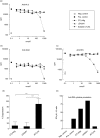Differential inhibition of autoreactive memory- and alloreactive naive T cell responses by soluble cytotoxic T lymphocyte antigen 4 (sCTLA4), CTLA4Ig and LEA29Y
- PMID: 17924973
- PMCID: PMC2219382
- DOI: 10.1111/j.1365-2249.2007.03513.x
Differential inhibition of autoreactive memory- and alloreactive naive T cell responses by soluble cytotoxic T lymphocyte antigen 4 (sCTLA4), CTLA4Ig and LEA29Y
Abstract
Cytotoxic T lymphocyte antigen 4 (CTLA4) is a potent inhibitory co-stimulatory molecule believed to be involved in type 1 diabetes and other autoimmune diseases. An association has been reported of both mRNA expression and serum levels of the soluble splice variant of CTLA4 (sCTLA4) with type 1 diabetes. Furthermore, recombinant fusion proteins CTLA4Ig and LEA29Y have been proposed as therapies for type 1 diabetes. We studied the role of (s)CTLA4 in islet autoimmunity. Binding capacity of the proteins to antigen-presenting cells was determined by flow cytometry in competition and binding assays. Functionality of sCTLA4 as well as the therapeutic inhibitory fusion proteins CTLA4Ig and LEA29Y was measured in a dose-response lymphocyte stimulation test, using a panel of diabetes-associated T cell clones reactive to islet autoantigens. As controls, mixed lymphocyte reactions (MLR) were performed to assess functionality of these proteins in a primary alloreactive setting. All three CTLA4 molecules were able to bind to antigen-presenting cells and inhibit the expression of CD80/CD86. sCTLA4 was able to suppress proliferation of different committed autoreactive T cell clones in a dose-dependent manner, whereas CTLA4Ig and LEA29Y were not. Conversely, CTLA4Ig and LEA29Y, rather than sCTLA4, were able to suppress naive alloreactive proliferation in a MLR. Our results indicate a differential role for sCTLA4, CTLA4Ig and LEA29Y proteins in memory versus primary immune responses with implications for efficacy in intervention therapy.
Figures



Similar articles
-
Blockade of multiple costimulatory receptors induces hyporesponsiveness: inhibition of CD2 plus CD28 pathways.Transplantation. 1996 Oct 15;62(7):1011-8. doi: 10.1097/00007890-199610150-00021. Transplantation. 1996. PMID: 8878397
-
A major costimulatory molecule on antigen-presenting cells, CTLA4 ligand A, is distinct from B7.J Exp Med. 1993 Nov 1;178(5):1789-93. doi: 10.1084/jem.178.5.1789. J Exp Med. 1993. PMID: 8228824 Free PMC article.
-
Cytotoxic T lymphocyte antigen 4 (CD152) regulates self-reactive T cells in BALB/c but not in the autoimmune NOD mouse.J Autoimmun. 2000 Mar;14(2):123-31. doi: 10.1006/jaut.1999.0353. J Autoimmun. 2000. PMID: 10677243
-
Complexities of CD28/B7: CTLA-4 costimulatory pathways in autoimmunity and transplantation.Annu Rev Immunol. 2001;19:225-52. doi: 10.1146/annurev.immunol.19.1.225. Annu Rev Immunol. 2001. PMID: 11244036 Review.
-
Co-stimulation in T cell responses.Curr Opin Immunol. 1997 Jun;9(3):396-404. doi: 10.1016/s0952-7915(97)80087-8. Curr Opin Immunol. 1997. PMID: 9203422 Review.
Cited by
-
The soluble form of CTLA-4 from serum of patients with autoimmune diseases regulates T-cell responses.Biomed Res Int. 2014;2014:215763. doi: 10.1155/2014/215763. Epub 2014 Jan 29. Biomed Res Int. 2014. PMID: 24605322 Free PMC article.
-
Diverse mechanisms regulate the surface expression of immunotherapeutic target ctla-4.Front Immunol. 2014 Dec 4;5:619. doi: 10.3389/fimmu.2014.00619. eCollection 2014. Front Immunol. 2014. PMID: 25538704 Free PMC article. Review.
-
Differential regulation of CTLA4 expression through BTK-dependent and independent mechanisms in CLL.Blood Adv. 2022 Sep 27;6(18):5440-5448. doi: 10.1182/bloodadvances.2021005571. Blood Adv. 2022. PMID: 35759759 Free PMC article.
-
Evaluation of six CTLA-4 polymorphisms in high-risk melanoma patients receiving adjuvant interferon therapy in the He13A/98 multicenter trial.J Transl Med. 2010 Nov 3;8:108. doi: 10.1186/1479-5876-8-108. J Transl Med. 2010. PMID: 21044351 Free PMC article.
-
Cytotoxic T lymphocyte antigen 4 expression in human breast cancer: implications for prognosis.Cancer Immunol Immunother. 2015 Jul;64(7):853-60. doi: 10.1007/s00262-015-1696-2. Epub 2015 Apr 17. Cancer Immunol Immunother. 2015. PMID: 25893809 Free PMC article.
References
-
- Walunas TL, Lenschow DJ, Bakker CY, et al. CTLA-4 can function as a negative regulator of T cell activation. Immunity. 1994;1:405–13. - PubMed
-
- Salomon B, Bluestone JA. Complexities of CD28/B7: CTLA-4 costimulatory pathways in autoimmunity and transplantation. Annu Rev Immunol. 2001;19:225–52. - PubMed
-
- Gough SC, Walker LS, Sansom DM. CTLA4 gene polymorphism and autoimmunity. Immunol Rev. 2005;204:102–15. - PubMed
-
- Chandraker A, Huurman V, Hallett K, et al. CTLA-4 is important in maintaining long-term survival of cardiac allografts. Transplantation. 2005;79:897–903. - PubMed
Publication types
MeSH terms
Substances
LinkOut - more resources
Full Text Sources
Other Literature Sources
Medical
Research Materials

